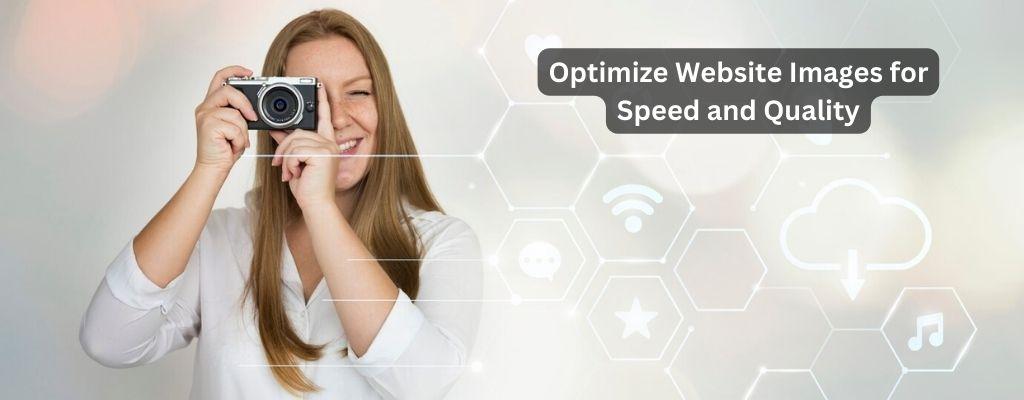
In the fast-paced and visually-driven world of the internet, optimize website images involves strategically compressing and refining file formats to enhance loading speed and overall quality, crucial for delivering an optimal user experience. the speed at which a website loads and the quality of its visual content are pivotal factors that can make or break user satisfaction. Optimize website images for both speed and quality is a nuanced process that requires a strategic approach. In this article, we’ll delve into the intricacies of image optimization, exploring why it’s essential, the techniques involved, and the tools that can be employed to strike the perfect balance.
Table of Contents
ToggleWhy Optimize Website Images Matters
1.1 The Speed Imperative
In the digital era, users are accustomed to instant gratification. Waiting for a website to load feels like an eternity, and research has consistently shown that longer load times lead to increased bounce rates. Google’s research indicates that as page load times increase from one to ten seconds, the probability of a user bouncing increases by 123%. Therefore, optimizing images for speed is not just a technical nicety; it’s a critical aspect of delivering a positive user experience.
1.2 The Visual Appeal
On the flip side, the visual appeal of a website is equally crucial. High-quality images not only enhance the aesthetic of a site but also contribute to its credibility and branding. Users are naturally drawn to visually pleasing content, and images play a significant role in conveying messages, emotions, and information. Finding the right equilibrium between loading speed and image quality is the challenge that web developers and designers face.
Types of Image Compression
2.1 Lossless vs. Lossy Compression
Lossless Compression: This method reduces file size without sacrificing image quality. It’s ideal for images where every detail matters, such as logos or graphics.
Lossy Compression: This technique achieves higher compression ratios by sacrificing some image quality. It’s suitable for photographs and situations where a minor loss of quality is acceptable to achieve a smaller file size.
The choice between lossless and lossy compression depends on the specific needs of each image and the overall objectives of the website.
2.2 Choosing the Right File Format
The file format of an image can significantly impact its size and quality. Understanding the characteristics of each format is crucial:
JPEG (Joint Photographic Experts Group): Ideal for photographs and images with gradients, JPEG offers a good compromise between image quality and file size.
PNG (Portable Network Graphics): Suitable for images with transparency or sharp edges, like logos and icons. PNG supports lossless compression but may result in larger file sizes.
WebP: Developed by Google, WebP is a modern image format that provides both lossy and lossless compression. It often achieves smaller file sizes without a significant loss of quality.
Selecting the appropriate file format involves considering the content and purpose of each image on the website.
Strategies for Image Optimization
3.1 Resizing Images for Web
Large images not only take longer to load but also consume more bandwidth. Resizing images to match the required dimensions of the website’s design ensures optimal loading times without sacrificing quality.
Tools for Resizing: Image editing software like Adobe Photoshop or online tools like Canva can be used to resize images while maintaining quality.
Responsive Images: Implement responsive images using HTML and CSS to ensure adaptability to different screen sizes, providing an optimal viewing experience on various devices.
3.2 Lazy Loading for Improved Performance
Lazy loading is a technique where images are loaded only when they are about to be displayed on the user’s screen. This can significantly reduce the initial page load time, particularly on websites with numerous images.
HTML Attributes for Lazy Loading: By incorporating the “loading” attribute in image tags with a value of “lazy,” lazy loading can be enabled.
JavaScript Libraries: Advanced libraries such as Intersection Observer can be used to implement lazy loading with more control and customization.
3.3 Content Delivery Networks (CDNs) and Image Optimization
Content Delivery Networks (CDNs) play a vital role in efficient image delivery. By distributing images across servers in various geographical locations, CDNs reduce latency and improve loading times.
Integration with CDNs: Partnering with a reliable CDN provider and integrating a website with their network ensures fast and seamless content delivery.
Image Compression on CDNs: Some CDNs offer image optimization services, automatically compressing and delivering images in the most efficient way possible.
Tools and Techniques
4.1 Image Editing Software
Image editing software provides a range of tools for optimizing images before they are uploaded to a website. These tools offer precise control over compression, resizing, and other factors affecting image quality.
Adobe Photoshop: A professional-grade tool offering advanced features for image editing and optimization.
GIMP (GNU Image Manipulation Program): An open-source alternative to Photoshop, providing powerful image editing capabilities.
Online Editors (Canva, Pixlr, etc.): User-friendly online editors are accessible and suitable for quick edits and optimizations.
4.2 Automated Compression Tools
For websites with a considerable volume of images, manual optimization might be impractical. Automated compression tools streamline the process, ensuring that all images maintain an optimal balance between speed and quality.
ImageOptim: A Mac application that automatically compresses images without compromising quality.
TinyPNG: An online tool that utilizes smart lossy compression techniques to reduce the file size of PNG and JPEG images.
4.3 Implementing Responsive Images
Responsive images adapt to different screen sizes and resolutions, ensuring users receive an optimal viewing experience on various devices. The “srcset” attribute in HTML is a powerful tool for implementing responsive images.
HTML “srcset” Attribute: This attribute allows the specification of multiple image sources and their respective sizes, enabling the browser to choose the most appropriate image based on the user’s device.
Conclusion
In conclusion, optimize website images for speed and quality is a multifaceted endeavor that requires a delicate balance. The need for speed is paramount, considering the impact on user satisfaction and search engine rankings. However, visual appeal and image quality should not be sacrificed in the pursuit of faster loading times. The strategies and tools discussed in this article provide a comprehensive guide for web developers and designers to navigate the complexities of image optimization.
As technology continues to advance and user expectations evolve, the importance of optimizing website images will only grow. Continuous learning and adaptation to emerging technologies and techniques are essential for ensuring that a website remains competitive in delivering a fast, visually appealing, and immersive user experience. Image optimization is not merely a technical requirement; it is an integral part of the broader effort to create a digital space that captivates users and communicates effectively through the language of visuals.

